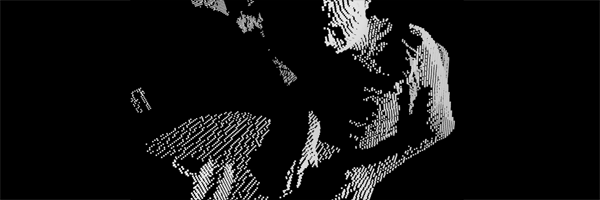What do you get when you mix together Python, Node.js, Three.js, CoffeeScript, WebGL, Websockets and a Kinect? If your answer was “A live-streaming, rotatable, zoomable 3D camera that wouldn’t be out of place on an episode of CSI”, you’d be right.
George MacKerron from the Centre for Advanced Spacial Analysis at University College London combined these things into DepthCam to allow us to look over his shoulder or snoop around his desk. It’s best viewed during UK office hours while George is at his desk but there is also a YouTube video showing it in action.
How it works
First, George records the depth image of his desk from the Kinect. This is a high-resolution 3D image which is then downsampled in Python and compressed using LZMA. The data stream is also compressed using an algorithm similar to MPEG-2 where the majority of frames only contain the differences between frames instead of the whole scene. Finally, this is streamed via a binary WebSocket to a node.js server
George programmed the client-side in CoffeeScript. The browser connects to the node.js server – again using binary WebSockets – to receive the compressed depth data in real time. This is then rendered in WebGL using three.js. The use of binary WebSockets means that this only works in an up-to-date version of Chrome or Firefox 11 but that’s the price of being cutting-edge.
Best of all, the whole project is available in GitHub. You can find out more technical details in on George MacKerron’s blog.
More
This isn’t the first time this kind of single-camera, 3D point-cloud representation has been used, indeed, Joel Gethin Lewes, Arturo Cassuro and perennial favourite Mr. doob used something similar to stream the 2011 Art&&Code conference in 3D. In that case, the heavy-lifting on the server-side was built using openFrameworks – a set of C++ tools for creative projects – and used cleverly encoded ogg/vorbis video to store the depth data. The source for this project is also available on GitHub. Unfortunately, there aren’t any videos of the conference but Mr. doob does have a similar looping interactive demo on his site.
For an AMA (Ask Me Anything) interview for Reddit, James George and Jonathan Minard filmed Golan Levin using a similar technique with the added complexity of a second camera to capture colour information, a technique James George has used in several projects. This required post-processing but, given that DepthCam is open-source, it might not be long before this can be done in real time as well.
This kind of 3D depth sensing technology has been available for a few years inside university research projects and complex art installations but so far it has always required expensive technology, hardcore server programming or a combination of both. It’s very exciting to see this is now completely possible using (soon-to-be) standard web technologies. In-browser 3D video chat would be an impressive direction to take it but once people start experimenting with the possibilities, it’s difficult to imagine where it could end up. CSI: 3D, anyone?
DepthCam
GitHub project for DepthCam
DepthCam on Youtube
George MacKerron’s blogpost about DepthCam
Mr. doob’s Kinect demo
Interview with Golan Levin

